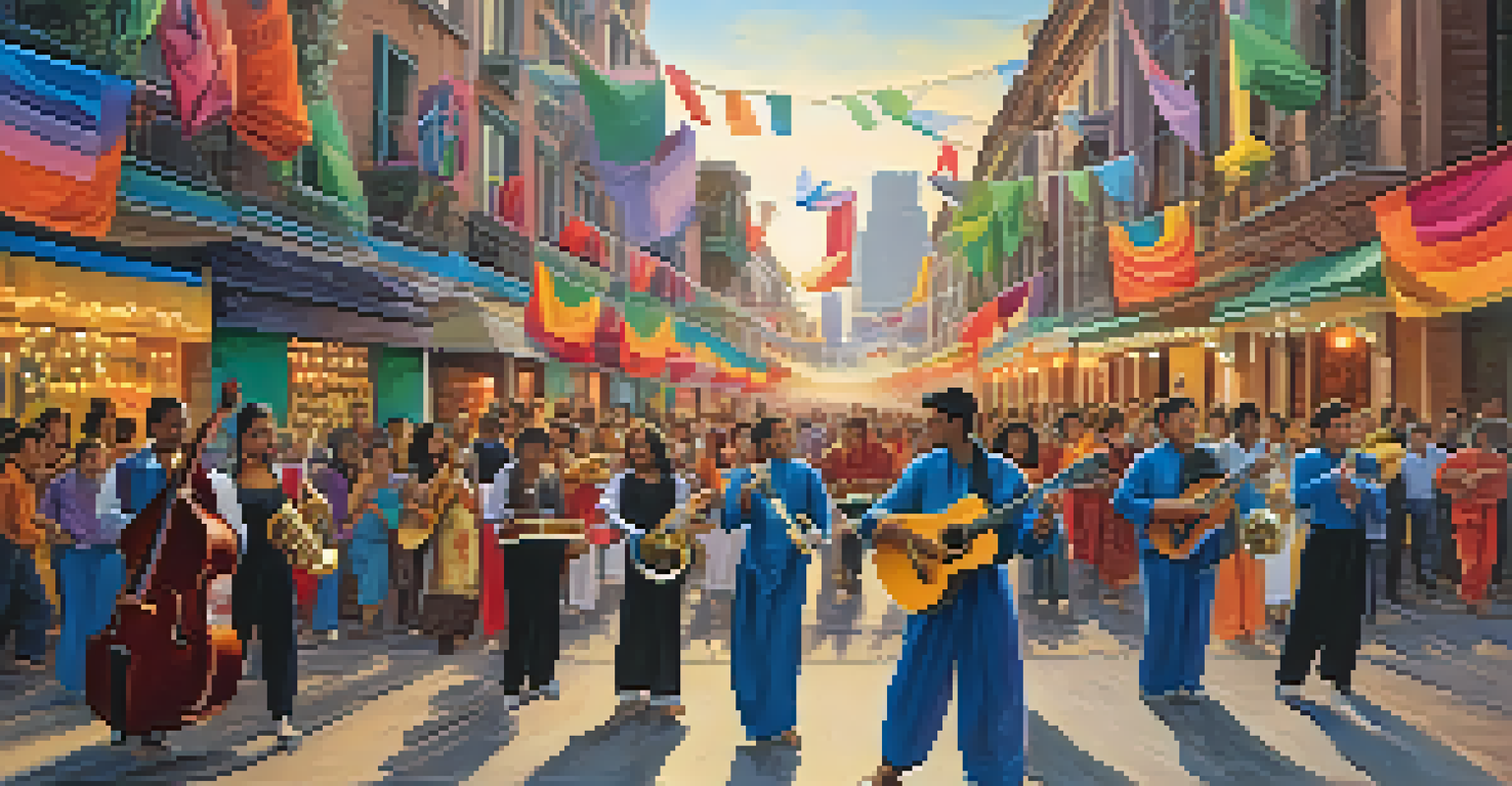Cultural Variations in Music as Nonverbal Communication

Understanding Music as a Form of Nonverbal Communication
Music, often called the universal language, transcends spoken words, conveying emotions and ideas that might be difficult to articulate. It's a powerful form of nonverbal communication that allows individuals to express feelings without uttering a single word. From a joyful melody to a somber tune, music taps into our emotions, creating connections that words sometimes cannot.
Music can change the world because it can change people.
Consider how a simple melody can evoke memories or feelings, transporting you back to a specific moment in time. Similarly, cultural contexts can shape how music is perceived; what sounds uplifting in one culture might feel melancholic in another. This demonstrates that while music is a shared human experience, its interpretations can vary widely across different societies.
In this way, music becomes a rich tapestry of cultural expression, where rhythms, tones, and melodies communicate messages deeply rooted in cultural traditions and values. Understanding this aspect of music helps us appreciate its role in human connection and communication across various cultures.
Cultural Context Shapes Musical Expression
Every culture has its own unique musical traditions that reflect its history, values, and social structures. For instance, indigenous music often incorporates natural sounds and rhythms that mirror the environment, creating a deep connection to the land. In contrast, urban music genres like hip-hop tell stories of personal experiences and social issues, serving as a voice for marginalized communities.

This cultural context not only influences the creation of music but also how it is received and interpreted by listeners. For example, the rhythmic beats of African drumming can symbolize community and togetherness, while Western classical music might emphasize individual expression and emotional depth. These differences highlight how music can communicate various societal norms and cultural narratives.
Music as Nonverbal Communication
Music transcends spoken language, conveying emotions and ideas that foster human connections.
As we explore these cultural variations, we uncover the layers of meaning embedded in musical forms around the world. Recognizing these influences allows us to appreciate how music serves as a reflection of cultural identity and a means of nonverbal communication.
The Role of Rhythm and Melody in Communication
Rhythm and melody are central components of music that enhance its communicative power. Rhythm, often associated with movement and energy, can convey urgency, joy, or even sadness. For example, a fast-paced rhythm might evoke excitement, while a slow, steady beat could symbolize reflection or mourning.
Where words fail, music speaks.
Melody, on the other hand, carries emotional weight and can express a wide range of feelings. A soaring melody can inspire hope, whereas a dissonant one might evoke tension or unease. These elements work together to create a musical language that speaks directly to our emotions, often bypassing our rational thought processes.
By understanding how rhythm and melody function in different cultural contexts, we can appreciate the complexity of musical communication. This knowledge deepens our connection to the music we hear, enriching our experience and understanding of diverse cultural expressions.
Examples of Cultural Music Traditions and Their Meanings
Around the globe, various musical traditions embody the values and narratives of their cultures. For instance, the use of call-and-response in African music reflects communal participation and dialogue, emphasizing the importance of community. Similarly, the blues genre in American music communicates themes of struggle and resilience, often rooted in the African American experience.
In contrast, traditional Indian classical music often employs intricate ragas that represent different times of day and seasons, linking music to the natural world. Each raga invokes specific emotions and is intended to connect the listener with deeper spiritual experiences. These examples illustrate how music serves as a vessel for cultural storytelling and emotional expression.
Cultural Context Influences Music
Different cultures shape musical traditions, reflecting their unique histories, values, and social structures.
By exploring these diverse musical traditions, we gain insights not only into the cultures they represent but also into the universal human experiences that music can communicate. This exploration highlights the significance of music as a form of nonverbal communication that resonates across cultural boundaries.
The Impact of Globalization on Musical Communication
In today's interconnected world, globalization has significantly influenced how music is created and shared. As cultures interact, musical styles blend and evolve, leading to new genres that reflect a fusion of cultural influences. This blending often results in a rich tapestry of sounds that can communicate messages beyond traditional cultural boundaries.
However, this phenomenon also raises questions about cultural appropriation, where elements of one culture are adopted by another without proper understanding or respect. This can lead to misunderstandings and misrepresentations of the original cultural significance behind the music. It's essential to approach these interactions with sensitivity and awareness of the cultural contexts involved.
As we navigate this global musical landscape, we must recognize the importance of preserving cultural identities while embracing the beauty of musical diversity. By doing so, we can foster a deeper appreciation for the ways music continues to serve as a vital form of nonverbal communication in our ever-changing world.
Music Therapy: Healing Through Nonverbal Communication
Music therapy is a powerful application of music as a form of nonverbal communication, providing healing and connection for individuals facing various challenges. Through rhythmic patterns and melodies, therapists can engage clients who may struggle with verbal expression, allowing them to communicate emotions and experiences in a different way. This approach has shown remarkable results in a variety of settings, including mental health, rehabilitation, and palliative care.
For example, individuals with autism may find it easier to express themselves through music than through spoken language. The nonverbal nature of music enables them to connect with their emotions and communicate in a safe space. Similarly, for those dealing with trauma, music can serve as a comforting presence that facilitates emotional release and healing.
Music Therapy Enhances Healing
Music therapy utilizes nonverbal communication to help individuals express emotions and promote healing.
By harnessing the power of music therapy, we can witness firsthand how nonverbal communication can bridge gaps in understanding and promote emotional well-being. This aspect of music further emphasizes its universal nature, demonstrating its ability to connect people across diverse backgrounds and experiences.
Conclusion: Embracing Music as a Universal Language
In conclusion, music stands as a remarkable form of nonverbal communication that transcends cultural boundaries. By exploring the variations in musical expression across different cultures, we gain insights into the rich tapestry of human experience and emotion. Music not only reflects cultural identity but also fosters connections among individuals, serving as a powerful tool for communication.
As we embrace the diversity of musical traditions, it's essential to approach them with respect and appreciation for their cultural significance. This understanding enhances our ability to engage with music meaningfully, allowing us to connect on a deeper level with others and the world around us.

Ultimately, music continues to be a universal language that communicates feelings and stories, bridging gaps and enriching our lives. As we listen and engage with music, let us celebrate its power to unite us in our shared human experience.